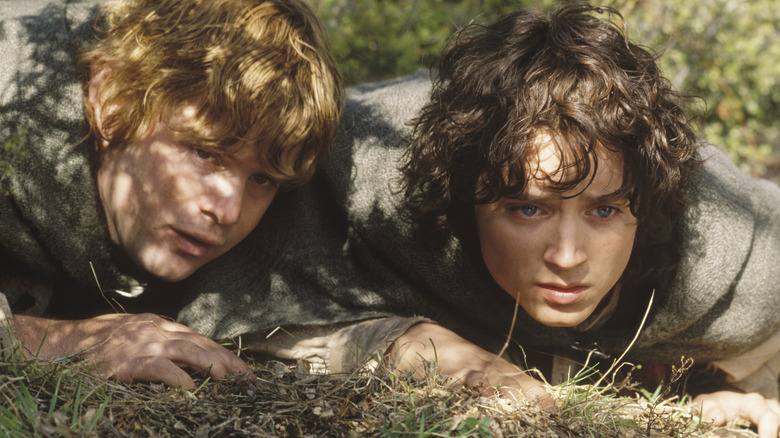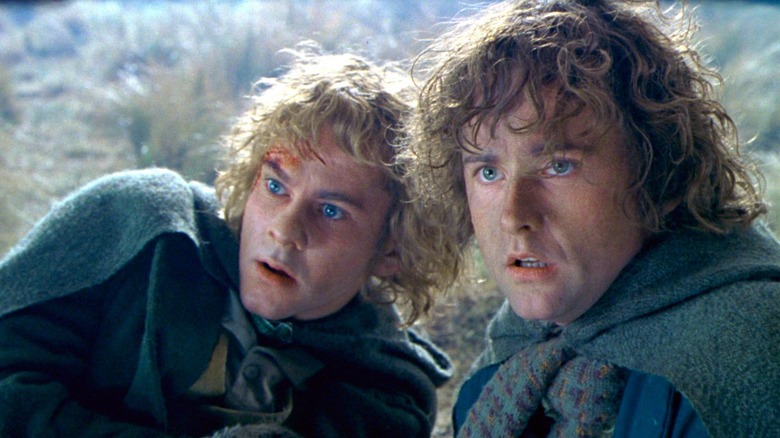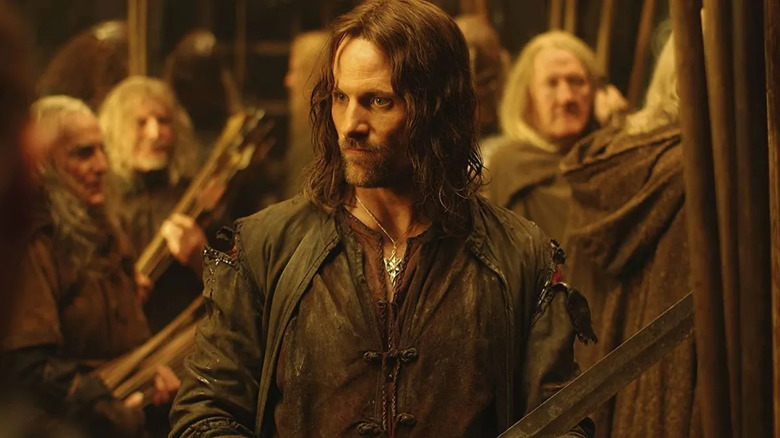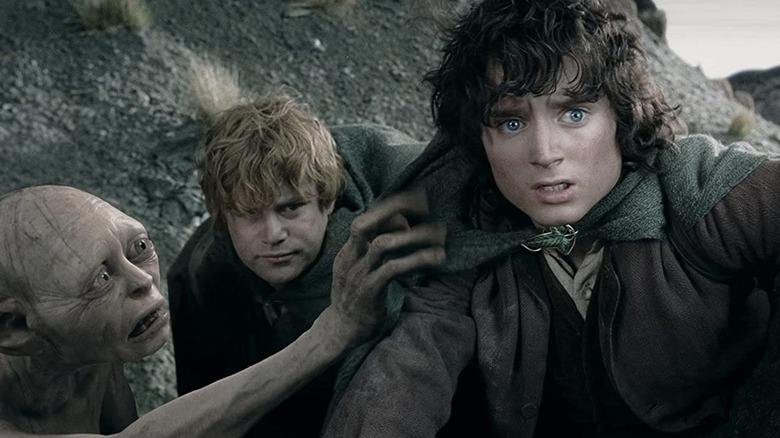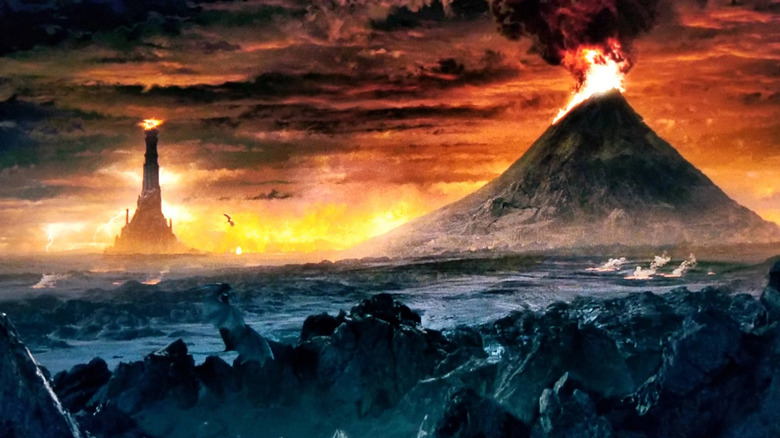The Lord Of The Rings: The Two Towers Ending Explained: Where Once Was Light, Now Darkness Falls
Middle films in a trilogy can be the hardest to make. In between the exciting world-building of the first film and the riveting conclusion, it can be difficult for the middle entry to stand on its own and still be as engaging as the bookends. "The Lord of the Rings: The Two Towers" is more than just a bridge between two epic films; it's a captivating journey all on its own. The Daily Mail describes the "The Two Towers" as achieving "a majestic proportion, chivalric and quixotic, earthly and magical, an experience that reaches beyond the dimensions of the cinema screen and somehow reflects the global unease of the world in the first years of the 21st century."
There is a somberness to the second film in "The Lord of the Rings" trilogy as Frodo becomes even more burdened by the Ring, Saruman's alliance with Sauron grows, and the enemies inch closer toward the defining battle of Helm's Deep. The darker themes of loss, war, and loneliness were particularly resonant to audiences in 2002, so soon after the tragedy of the September 11, 2001 terrorist attacks.
"The Two Towers" picks up immediately after "The Fellowship of the Ring" left the nine companions fractured and on separate journeys. After Boromir's death and his attempt to take the Ring from Frodo, the hobbit leaves for Mordor with a devoted Sam at his side. Merry and Pippin are captured by the rest of the Orcs and Uruk-hai, and Legolas, Gimli, and Aragorn set off to rescue them. Peter Jackson juggles the different stories and settings with masterful precision. He effortlessly interweaves the splintered narratives to build tension as Middle-earth approaches war.
The fall of Isengard
By the end of "The Two Towers," Merry and Pippin become important players in Middle-earth's struggle for peace. Their storyline illustrates how good actions — no matter how small — can make significant progress toward victory. After they are captured by the enemy, the crafty hobbits manage to escape to the Fangorn Forest, where they meet Treebeard, a creature called an Ent who is a giant walking tree with a booming voice. The Ents live a quiet life and move and speak very slowly; their listless ways frustrate the high-energy hobbits, especially when the trees resolve to stay out of the impending war. Merry and Pippin eventually convince the Ents to fight for their beloved forest, which has been destroyed by Saruman to create weapons for his army.
The "Last March of the Ents" is a rousing scene where the towering creatures infiltrate Isengard. "RELEASE THE RIVER!" one of them thunders, sending a rush of water through Saruman's war machines. (Take note of the hilarious background bit where an Ent puts out the fire in his tree-hair by submerging his head in the water!) "The Two Towers" marks a significant turning point for Merry and Pippin. They are no longer just a goofy pair of hobbits, or a "fool of a Took." They are growing into sharp, compassionate leaders who understand the importance of coming together to defeat evil. The ending of Merry and Pippin's storyline illustrates how the hobbits have lost their initial innocence and found a courage they never knew they had as they join the battle for Middle-earth.
The battle of Helm's Deep
Aragorn, Legolas, and Gimli meet Gandalf, who has been reborn as Gandalf the White. Their journey in "The Two Towers" ends with the 40-minute battle of Helm's Deep. Saruman sends his army to Rohan to claim the land for himself and strengthen his power so he can eventually seize the Ring and take over Middle-earth. The battle is one of the most epic war sequences committed to film. Peter Jackson skillfully balances humorous moments (Legolas surfing on a shield, Gimli being too short to see over the wall, etc.) with pulse-pounding action that is timed to perfection.
The blinding darkness and pouring rain creates a terrifying atmosphere as 10,000 formidable Uruk-hai climb and smash into the fortress Hornburg. The stronghold was their only chance of defeating the enemy, but with only hundreds of Rohirrim soldiers on their side, any man — regardless of age — must aid the fight, and survival is unlikely. The shots of their worried faces and crying families capture the human emotions of the fantasy battle.
Aragorn courageously charges the Uruk-hai army on horseback so Rohirrim women and children can escape into the Glittering Caves. When the riders are outnumbered and surrounded, all seems lost until Aragorn sees Gandalf illuminated at the top of the hill with Éomer and 2,000 Riders of Rohan. The light of hope rushes in as they descend down the hill and annihilate the enemy. Despite Saruman's defeat, Gandalf considers Helm's Deep a prelude to the full war that is about to unleash. Everything now depends on Frodo and Sam finding Mordor.
'There's some good in this world ...'
Frodo and Sam come across Gollum, a pitiful creature emaciated and driven mad by carrying the ring for so long. He is a reflection of the enormous power the Ring holds and Frodo's future if he succumbs to its temptation. The former hobbit has two personalities: a caring guide who wants to help his new friends on their adventure, and an vindictive manipulator who will stop at nothing to be reunited with his "precious."
After Faramir captures the trio, he plans to bring the Ring to his cruel father, Denethor. Passing through the besieged city of Osgiliath, Frodo tries to explain the true nature of the Ring and urges to be released. After Sam saves Frodo from a Nazgûl, he launches into a monologue that is one of the most moving moments in the entire trilogy:
"But in the end, it's only a passing thing, this shadow. Even darkness must pass. A new day will come. And when the sun shines it will shine out the clearer. Folk in those stories had lots of chances of turning back only they didn't. Because they were holding on to something ... That there's some good in this world, Mr. Frodo. And it's worth fighting for."
Jackson creates an uplifting moment when he intercuts the poignant lines with the victories at Helm's Deep and Isengard. Faramir finds the strength his brother did not have and resists the Ring, releasing the hobbits for the greater good of Middle-earth. The scene delivers a powerful message about believing good will always triumph over evil. It reassures audiences they will always see through the worst of times.
Sauron's watchful eye
In the final sequence, Gollum leads Frodo and Sam further into the forest. His split personalities secretly devise a plan to reclaim the Ring by taking the hobbits to a mysterious "Her," the venomous spider Shelob at Cirith Ungol. The camera pans up from the thorny forest, rolling upwards past a black, rocky mountainside to twin towers of evil: Barad-dûr, where Sauron's flaming, watchful eye looms, and Mount Doom, where menacing smoke and flames fill the sky with its amber colors. Nazgul fly in circles, hunting for their prey. The apocalyptic image is chilling and hints toward the enormous battles and foes that still lie ahead. The arduous challenges of Helm's Deep and defeating Saruman were just the beginning.
"The Lord of the Rings: The Two Towers" is very different from the previous installment, which felt more like an innocent adventure before the fellowship met the reality of death and brutal warfare. The end credits song, "Gollum's Song," crystallizes the gloom that permeates the film. Emilíana Torrini's slinky, almost childish voice captures Gollum's suffering, the heartbreaking character that is the center of this film. His fears of never returning home and of being alone are felt by the nine companions on their fragmented journeys. They fear there will be no light, no victory in this great battle. Betrayed and hurt by his friends, Gollum no longer sees good in the world, but the rest of the fellowship must hold onto that belief so they can defeat Sauron.
